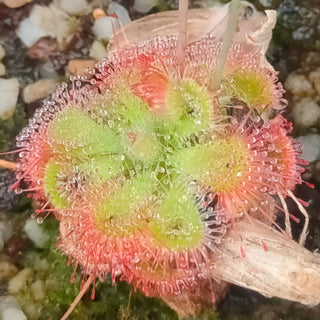Linaria vulgaris
YELLOW COMMON TOADFLAX
- Unit price
- / per
Linaria vulgaris, the common toadflax, yellow toadflax or butter-and-eggs, is native to Europe, Siberia and Central Asia, and has also been introduced and is now naturalized in many U.S. states and Canadian provinces.
The flowers are similar to those of the snapdragon, pale yellow except for the lower tip which is orange. The flowers are mostly visited by bumblebees, and are a food plant for a large number of moths and butterflies.
While most commonly found as a wildflower, toadflax is sometimes cultivated for cut flowers, which are long-lasting in the vase. Like snapdragons (Antirrhinum), they are often grown in children's gardens for the "snapping" flowers which can be made to "talk" by squeezing them at the base of the corolla.
The plant requires ample drainage, but is otherwise adaptable to a variety of conditions.
This plant has been used in folk medicine for a variety of ailments.
Type: Hardy perennial
Height: 30", 75cm
Location: Sun
Hardiness zones: 3-8
Sow just under the surface of the soil and water in. Then cover them with plastic and place in a fridge for 90 days. Be sure they stay moist. After the cold stratification they are then brought back to room temperature 20-22°C (68-72°F) for them to germinate. Germination is irregular over a long period of time, generally 60-90 days, but some can take longer. Do not discard the planting tray, as patience is needed, and they are well worth the wait.
Ornamental use only. Toxicity unknown.
Linaria vulgaris
YELLOW COMMON TOADFLAX
- Unit price
- / per
Multiple secure payment options available.
Adding product to your cart
You may also like
Linaria vulgaris, the common toadflax, yellow toadflax or butter-and-eggs, is native to Europe, Siberia and Central Asia, and has also been introduced and is now naturalized in many U.S. states and Canadian provinces.
The flowers are similar to those of the snapdragon, pale yellow except for the lower tip which is orange. The flowers are mostly visited by bumblebees, and are a food plant for a large number of moths and butterflies.
While most commonly found as a wildflower, toadflax is sometimes cultivated for cut flowers, which are long-lasting in the vase. Like snapdragons (Antirrhinum), they are often grown in children's gardens for the "snapping" flowers which can be made to "talk" by squeezing them at the base of the corolla.
The plant requires ample drainage, but is otherwise adaptable to a variety of conditions.
This plant has been used in folk medicine for a variety of ailments.
Type: Hardy perennial
Height: 30", 75cm
Location: Sun
Hardiness zones: 3-8
Sow just under the surface of the soil and water in. Then cover them with plastic and place in a fridge for 90 days. Be sure they stay moist. After the cold stratification they are then brought back to room temperature 20-22°C (68-72°F) for them to germinate. Germination is irregular over a long period of time, generally 60-90 days, but some can take longer. Do not discard the planting tray, as patience is needed, and they are well worth the wait.
Ornamental use only. Toxicity unknown.





















































